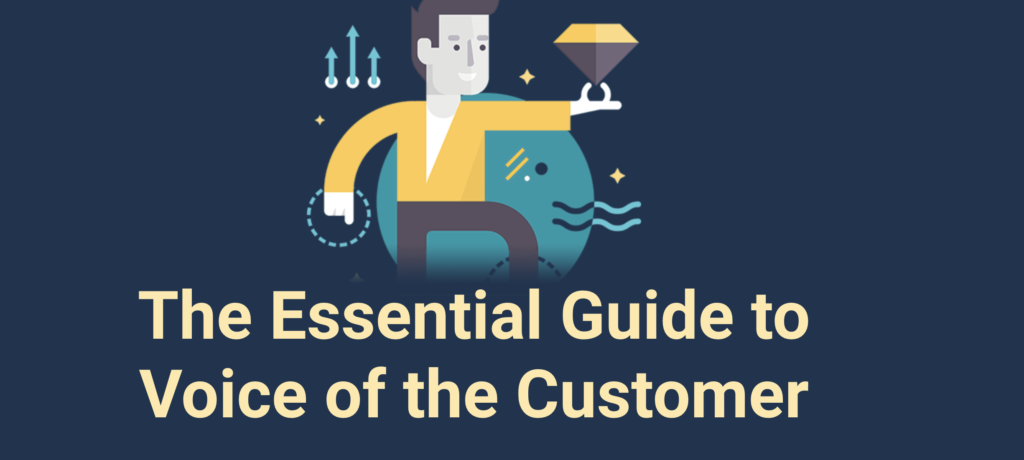Ask any CX or marketing expert, and you’ll immediately know that the customer marketing landscape with one-way dialogue is a thing of the past. According to research by Bain & Co., companies that excel at customer experience, paying heed to consumer feedback, experience 4-8% growth in their revenue against their competition.
To that effect, today, industry leaders are quickly adapting to the voice of the customer (VoC) programs as they represent an enormous opportunity for driving sales and building relationships.
But what is VoC? How does it impact your business? And what can you do to build a VoC analytics program? Let’s find out.
What is the voice of the customer?
VoC is more than just jargon. Companies can use this method to understand and describe customers’ expectations for their products and services and the feedback from their experiences.The feedback received is highly valuable data — and analytics programs built around it have proven to increase CLV by understanding how people perceive and interact with brands.
VoC programs have attracted a lot of attention in the past few years and constitute one of the most explosive core business strategies for organizations. Customers engage more directly with brands, and their feedback becomes critical in understanding how they come to a decision.
How voice of the customer impacts your business
VoC programs have proven to be extremely beneficial for businesses in multiple areas. For instance, it helps you build better products, deliver more optimized services, and systematically understand CX to help you retain customers. And this is no joke because more than 89% of the companies are competing strictly on customer experience.
If you understand the importance of your customer journey, VoC will help you fulfill their ever-evolving requirements, which, again, will foster their loyalty.
In more quantifiable terms, it is bound to bring results in the following:
- Cultural Changes: You can promote a paradigm shift in the culture by driving customer-centric changes.
- Costs: Ensuring compliance and creating more consistent processes, you can expect reduced costs.
- Revenue: Given the reduced churn, newly acquired customers, and overall improved cross-sell opportunities, revenue is expected to grow steeply.
There’s more to VoC than sending out surveys and expecting favorable responses. In a way, that though is the very antithesis of the reason behind conducting VoC analytics programs.
8 steps for building the program
Here we have listed 8 critical steps which surmise the approach that you must take to build a successful VoC analytics program from scratch.
1. Identify your core question
A powerful VoC analytics program tries to solve as many problems as possible. And for you to think of solutions and effect any change, you must first find the questions. In other words, identifying the questions takes precedence over everything else.
Every question should be an invitation for actionable feedback and discussion and make the customer feel that they are making a difference. Questions whose replies allow customers to validate the existing company policies and behavior don’t solve anything and negate the sheer purpose.
On the same note, if the questions are somehow optimized to achieve your desired outcomes, that’s well-geared.
The questions you ask directly impact the data you’ll gather, the analytics tools you’ll use, and the analysis you end up performing. If you don’t have any clear questions in mind, that’s perfectly fine. You can ask something expansive and inclusive like “Can we see the feedback from the customers who used this product?” and improve on it later.
2. Set up a CX team
The voice of the customer is not an agenda for a round-table meeting. Your organization’s strategic ideology has to commit to – to set a new direction for CX. To that effect, it’s ideal that there be a team dedicated to this mission.
A dedicated CX team can co-create new experiences with customers, identify metrics, and above all, educate the entire organization about the importance of CX. A CX team that manages a VoC program ensures that the communication channel of actionable business insights is linked to the correct business units, and by extension, the business outcome.
3. Collect data from various sources
Now that you have some idea of what question to ask, it’s time to get the answers. Here are some of the major sources from where you can source the VoC data:
i. Customer interviews
Nothing like interviewing a customer. It is probably among the most traditional techniques to collect VoC data, but definitely, an effective one if done right. It is typically used to understand why your customer likes your product, what you can do to be more relevant to them, understand their world view, attributes, and performance measures.
ii. Surveys
Surveys that include NPS perhaps offer the most simplified structures to gather customer feedback. It is scalable, and you can target any stage in the buying cycle depending on your goals.
iii. Chat conversations
Live chat software is an interesting way to collect customer data’s voice, and as we advance, not integrating it in your feedback data collection loop could be a costly mistake. According to a study, 48% of the customers use it to reach out to a company.
iv. Listening to customer calls and automated note-taking
Here’s another approach to understanding the voice of the customer. There are a lot of meeting assistant tools that help you in listening to sales calls, customer support calls, and more, which can, in turn, be used to democratize customer intelligence across the organization. These tools tend to have automated note-taking capability, i.e., it uses technology such as artificial intelligence (AI) to capture keynotes from a conversation or an online meeting in the form of bullets, which you can skim through pretty quickly.
v. Social media
You can solicit feedback via mentions and DMs. Social media is useful for immediate and in-the-moment conversations and solves the purpose of sentiment analysis. You can also create and announce hashtags and conduct polls to streamline feedback.
You may also go for third-party aggregators or omnichannel feedback tools to source the data if the above manual methods don’t work for you.
4. Choose the right VoC tools
Various VoC tools can leverage the customer data fed to them, parse it and support multi-channel feedback. The main categories have been classified as under:
- Customer Journey: These voice-of-the-customer tools monitor consumer’s every action and generate insights based on their movement in between your offerings.
- Automation: These tools automatically trigger actions in response to customer feedback.
- Reporting and Analytics: These tools are responsible for measuring customers’ effort and satisfaction and analyzing the data with optimal metrics.
Everything said, factors like the quality of the analytics offered and the ease of integration with your existing CRM software will play a huge role in you finalizing the right software for your business.
5. Prioritize customer satisfaction as a key metric
The VoC software running analytics are machine learning tools that improve their results from selective feedback. The only feedback metric that matters, though, is whether the customer is satisfied. You can create your metrics depending on your objectives. For instance, a retail business could use the average acceptance rate of step count for an order process as a metric. Nonetheless, asking whether the customer is overall satisfied lends a holistic view to the response.
All brands looking to adapt to growing customer demands proactively must think of customer satisfaction as the cornerstone of their customer analytics program’s voice.
6. Analyze and troubleshoot
The measurement of your voice of the customer program involves analyzing qualitative data obtained from the customers. As mentioned earlier, the sources can be anything from live chat to surveys and polls. And now that you have robust data to work with, it’s time to create a game plan. Here’s the step-by-step process:
- Gauge your program’s success through the number of responses received from surveys, social media outreach, and live chat feedback.
- Pinpoint common trends, see whether there is something common that your customers expect from you, like chat support, or whether most of them are happy with the services you offer.
- Summarize your research in a reference document, and include these new insights in your buyer persona and employee training programs.
- Visualize the newly discovered data through Excel or Google Sheets or perhaps a dedicated reporting tool.
- From the visual trends, you discover, create an actionable game plan and present it to your CX team.
7. Draw conclusion
While the VoC tools are generally sophisticated enough to conduct useful analysis, they often struggle to disseminate the insights. But while proper communication of insights is paramount, even if you channel the insights to the right people, you may still be ineffective in bringing any change. The bigger problem is not getting information out but making it actionable.
As an organization, as you leverage dashboards and reports as CTAs, everything that needs to be done must be spelled out with reasoning.
The key insights from the collected data will tell you which area requires immediate action. Analyzing it, as mentioned above, across labels, ratings, dates, etc., can help you draw conclusions and prepare an action plan.
8. Translate into action
There’s nothing worse and annoying than asking for feedback when it doesn’t translate into action. So, get started on a voice of the customer program only after you’re prepared to follow through.
You must continue to monitor and track your program’s progress and pinpoint the areas that demand more attention. Turning insights into actions will help you introduce a paradigm shift in your customers’ journey and drive holistic change in your organization to promote customer-centricity.


Final words…
Every successful business understands the importance of customer feedback in tandem with the data and how it improves their product. Only by proactively developing and implementing a voice of the customer program can you hope to understand what buyers need before making a buying decision and what you can do about the customer journey as a whole.
Yes, communicating with the customers and conducting your research can be time-consuming and will take a lot of work, but the payoff at the end of it is priceless.

[…] The common thread that weaves across all of the above is customer retention. And nothing will get you to retain your customers if you don’t understand the voice of the customers (VOC). […]